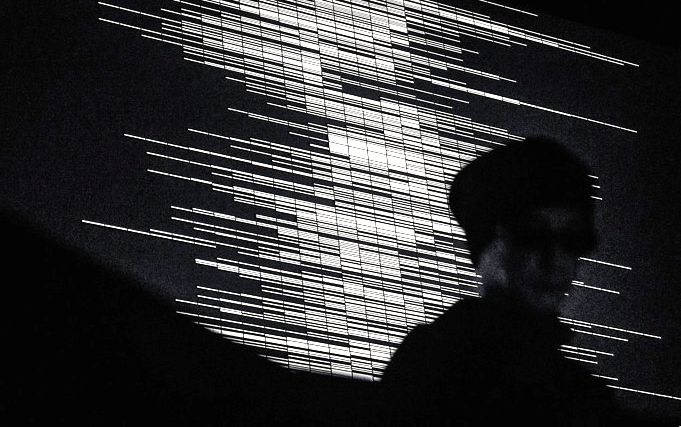Ryoji Ikeda – Live @ Village Underground
aaamusic | On 28, May 2015
Wednesday 27th May, London
Ryoji Ikeda played an intense show entitled Supercodex to a packed out crowd at Village Underground. This show, organized by the Barbican, coincided with the last few days of Ikeda’s first major solo exhibition in London, Supersymmetry, presented by The Vinyl Factory at Brewer Street Car Park.
Supercodex has been billed by the Village Underground as a transformation of the exhibition into an immersive live show. In order to make some headway with the latter, it thus seems important to know something of the former. Ikeda’s exhibition is comprised of two installations. In the first room, there are three light boxes, which provide a surface for a number of ball bearings to move around. In the second room, there are two long rows of monitors displaying data, which is a visual translation of the movement of the ball bearings in the first room. Once the connection has been made between the displays in each room, it becomes possible to understand what Ikeda is trying to render sensible: how the findings of scientific experiments are translated into data, and the aesthetics of ‘raw data’ itself. It seems he finds something generative in this process, and he uses it to full effect in his live performances.
Tonight’s performance sees Ikeda engaging in similar processes of translation. One gets the sense – hinted at through his use of code in some of the visuals – that data and mathematical models are being used to generate the music and projections. In effect, both seem to operate representations of digital data. At the start of the performance, Ikeda blasted the audience with various digital noises, frequencies and drones. However, as the performance went on, these disparate, seemingly unrelated sounds start to take form, building into complex compositions. Here, it starts to sound like a kind of stripped back electronic music, free from the easy hooks and nice melodies of more commercial dance music.
Ikeda’s performance didn’t present his audience with a continual build to a climatic moment. Instead, it seems to establish specific moments of intensity, which would then fade out. It is clear that Ikeda has a certain disregard for the conventions that often surround events like this. He doesn’t care for interaction with the crowd. Nor does he acknowledge applause. The moments in his set where he’s not blasting sounds into the space feel more like periods of reduced intensity than moments carved out for recognition. In fact, his set cut the audience’s applause short at every opportunity. It thus feels more like a performance than a gig.
Ikeda’s use of visuals adds to the intensity of his performance. For the majority of tonight’s show, Ikeda’s visuals were comprised of two columns. Black and white blocks flashed and sine waves sparked. It was unnerving and relentless. Different motifs returned and were layered on top of one another, as he repeated sounds he’d used before.
Much is often made of the fact that Ikeda’s practice is difficult to define. It defies neat categorization. Similarly, Ikeda’s performance is resistant to straightforward acts of interpretation. Yet, at the same time, it feels powerful and convincing. Ikeda engages head-on with the digital structures that code the more comfortable representations of modern life, and the results are unsettling.


